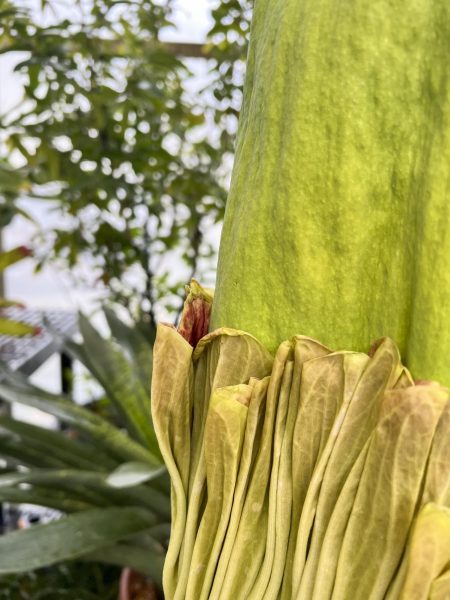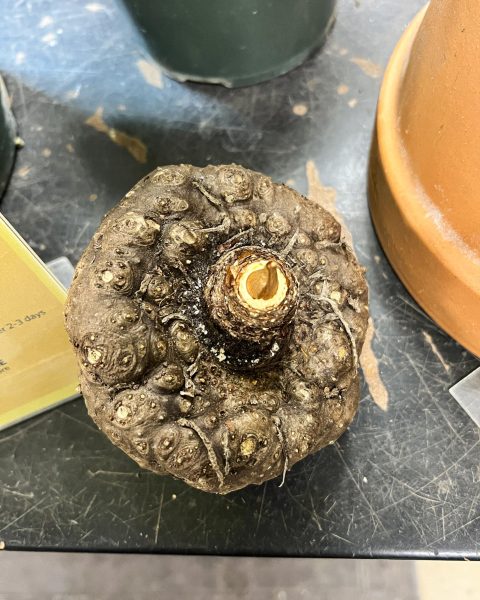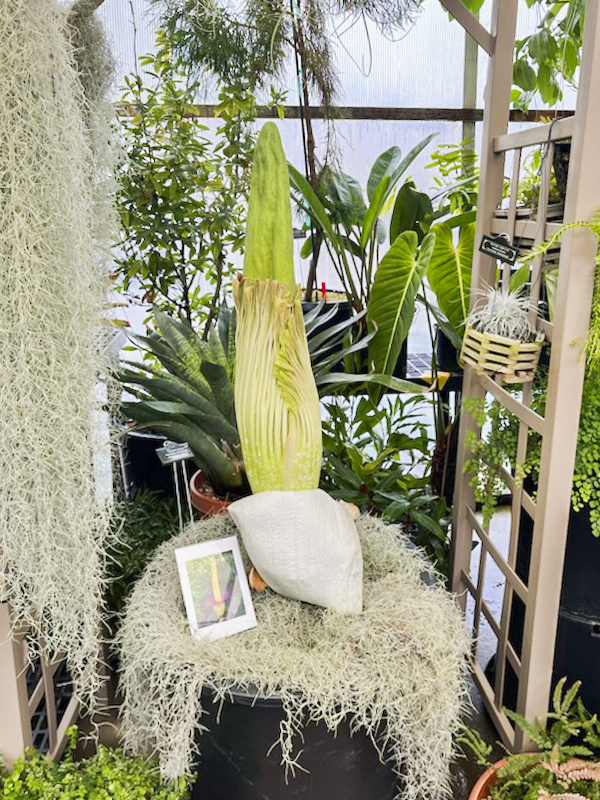Hiding away from the hustle and bustle of Blowing Rock Road, nestled beneath a hill across from the State Farm lot, is the App State Department of Biology Greenhouse, a plant lover’s wonderland.
For Jerry Meyer, greenhouse manager, the greenhouse is just that: a wonderland of thousands of plants he’s cared for over his 15 years as manager. This week, the greenhouse is filled with a little extra enthusiasm, as the rare “corpse flower” plant is blooming for the first time.
Home to roughly 1,500 plant species, the greenhouse serves as a sanctuary for native and exotic plants, over 100 of which are endangered or critically endangered. Meyer said the greenhouse is home to at least one species from every country recognized by the United Nations.
Among these endangered plants is the university’s Titan Arum, commonly known as the “corpse flower.”
The corpse flower is a large plant, native only to the rainforests of the Indonesian Island of Sumatra. According to The International Union for Conservation of Nature Red List of Threatened Species, only roughly 1,000 corpse flowers are remaining in Sumatra due to deforestation and urbanization. There are only roughly 90 conservatories across the globe who grow this species; App State is among these.
Meyer said the plant came to App State in 2011 as a gracious gift from the Atlanta Botanical Garden. When the greenhouse received the plant, they named it Mongo after a nickname given to Meyer in high school.
Meyer has been caring for Mongo since the plant first arrived in Boone, and this is the first time the plant has bloomed since its arrival.
Chad Wunderlich, a longtime volunteer at the greenhouse, is typically involved with sourcing plants for the greenhouse. He said this sharing of plant material is based on friendships.
“The lineage of endangered tropical plants is carried on by sharing of material. Some institutions understand the very principle that by sharing something is preserving the lineage of the plant,” he said. “That was the whole thing with Mongo. Ten, 15 years ago, there wasn’t a lot around. The very fact that we got one back then was an understanding that we would preserve it for the public to see it bloom.”
The bloom cycle of the corpse flower is highly complicated and pretty rare.
“Mongo is around 15 years old, and this is the first time the plant has decided to bloom. It is very difficult to find information online about predicting when the plant will bloom,” Meyer said.
He said he has been doing research for years now on how to identify when the plant will bloom.

(Briley Turpin )
“We have no way to know, but we are noticing the leaf around the base of the plant is turning a maroon color,” he said.
This color change is one of the first indications of bloom, Meyer said. The plant only blooms for a few days every couple years after maturity, and this blooming cycle is incredibly unpredictable.
Meyer said Mongo arrived at the facility as a fist-sized corm, or a large underground stem used to store energy for the plant. Mongo is now 30 pounds with a 12-inch corm.
The life cycle of a corpse flower is nearly as complicated as its bloom cycle. In captivity, the corm is planted in a pot with sterile growing mix.
As the plant grows, the corm grows larger underground until a leaf begins to sprout up through the dirt. This individual leaf, called a petiole, grows like a tree and serves to feed the plant as it matures.
This leaf dies, and the process repeats again. When the plant reaches maturity, the first bloom occurs. Wunderlich said the blooming process expends a massive amount of the plant’s energy, and each petiole growth operates as a way to save energy for the plant through photosynthesis.
A contributing factor to the plant’s status as endangered is the fact that it can only reproduce when there are two plants blooming at the same time. The bloom is known for the smell it produces, which has been compared to that of rotting meat, hence the name “corpse flower.”
This smell attracts pollinators, such as flies and beetles, that lay their eggs in the rotting corpses of animals in the forest. These pollinators land on the plant and collect its pollen. Under ideal conditions, the pollinators will land on the blooming plant and carry its pollen to another blooming flower.
“To know that this little island in Indonesia, that isn’t very big, houses something as majestic, and big and beautiful as this plant, that is now here, helps to show people ‘Hey, this is something that needs to be preserved in the wild,’” Wunderlich said. “From this, you can understand that in Appalachia, we’ve got endangered species on the mountain faces that are endangered because they’re endemic to this location, and that’s what Mongo represents for us.”
Because the bloom is so rare, greenhouse workers, volunteers and members of the Boone community are all extremely excited about Mongo’s first bloom.
Rachel Rollison, a senior creative writing major, said she came to the greenhouse as soon as she heard Mongo was blooming.
“This has been a bucket list thing for me. You don’t get to see these every day. I had no idea we had one in Boone, so I was super excited to come see it,” she said.
Wunderlich said plants have their own way of knowing when the time is right to bloom. He said Mongo couldn’t have picked a better time, as this will be the first and only time the plant will bloom in that greenhouse.

(Briley Turpin )
As part of the App State innovation district, the university is building The Conservatory for Biodiversity Education and Research, where Mongo, along with many of the other plants in the greenhouse, will be moved upon completion.
It is clear that plants are Meyer’s passion. Walking around the greenhouse, his face lit up with every opportunity he had to talk about a plant species. He is excited to help create a space where each plant has room to grow and thrive with other similar species.
“I am proud of having served in the U.S. military. I bring a lot of the good stuff from my experience to the greenhouse. When I was a captain in the Air Force, I took my first trip to a truly wet tropical environment, where I saw these huge plants in front of homes. Something clicked, and I thought, ‘Jerry, put down your rifle and switch careers,’” Meyer said. “That was the moment.”
The corpse flower is expected to bloom sometime this week, but as aforementioned, it’s difficult to predict exactly when. To see the bloom status, tune in to the greenhouse livestream. Greenhouse doors will remain open to the public from 8 a.m.- 4 p.m. through Nov. 17.








Robert Gene Turpin • Nov 16, 2023 at 9:14 am
A great article about the Corpse flower.
Lee Gilman • Nov 16, 2023 at 7:41 am
This is so exciting!!! Isn’t there a way to have extended hours for this spectacle as it fully opens at night and lasts less than a day. It truly is a must see event!